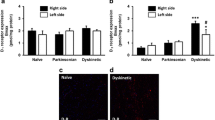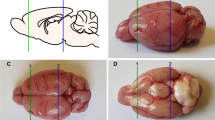Summary.
To assess the role of dopamine receptors in the genesis of dyskinesia, we have used quantitative autoradiography to determine the effect of chronic l-dopa administration on dopamine D-1 (using [3H]SCH 23390), D-2 (using [3H]spiperone) and D-3 (using [3H]7-OH-DPAT) receptor binding levels in the striatum of dyskinetic or non-dyskinetic monkeys. Total and subregional striatal analysis showed no difference in D-1, D-2 or D-3 receptor binding in the caudate and putamen between monkeys receiving high dose l-dopa treatment with marked dyskinesia and those without dyskinesia compared to untreated animals. It thus appears unlikely that changes in dopamine receptor expression are a primary cause of l-dopa induced dyskinesia. Rather, a functional dissociation of D-2 receptor coupling to co-expressed enkephalin/adenosine-2a receptor activity in the striato-GPe indirect pathway may be more important in the development or expression of l-dopa-induced involuntary movements.
Similar content being viewed by others
Author information
Authors and Affiliations
Additional information
Received July 3, 2000; accepted March 13, 2001
Rights and permissions
About this article
Cite this article
Zeng, BY., Pearce, R., MacKenzie, G. et al. Chronic high dose l-dopa treatment does not alter the levels of dopamine D-1, D-2 or D-3 receptor in the striatum of normal monkeys: an autoradiographic study. J Neural Transm 108, 925–941 (2001). https://doi.org/10.1007/s007020170013
Issue Date:
DOI: https://doi.org/10.1007/s007020170013




